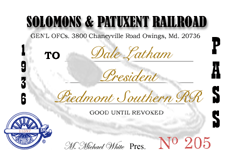
Operations planning
on the S&P is affected by the times (1936), the national economy
(the Depression), the geography (tidewater), and the local
economic base (agricultture, fisheries, retail). As it turns out,
everything is interelated and affects decisions about everything else.
The S&P is a short line railroad operating over flat terrain or moderate grades (geography) using small, older locomootives and rolling stock (times), serving customers who operate farms, seafood packing houses, sawmills, building materials supply, groceries, agricultural products processors, and fuel dealers (agriculture, fisheries, retail).
Remaining faithful to the historical context of the area while modeling a railroad in a place that never really experienced railroad infrastructure and operations posed some interesting questiions. Some examples: Where did the money come from and how much?, What would be the route?, Where would stations be likely to be located. What new businesses would develop as a consequence of the railroad that would integrate with the economy of the area? What types of business would grow faster or larger than others as a result of the availability of rail transportation? What would be the railroad's incentive and capabilities for passenger operations? To what extent would passenger operations impact freight traffic? How would passenger operations interconnect with existing railroads? What was a likely interchange arrangement between the railroad and other railroads in the area?
As a result of all of these questions, the track plan and benchwork has undergone several revisions both before and after some was already built. It is still subject to being revised further and probably will be. I'm a strong believer that a freelance model railroad should be internally logical and make sense . There should be reason for everything seen on the model railroad - route, equipment, structures, terrain, scenery - otherwise, an internally illogical layout will be the result.
.
What follows is the result of taking all of the above into consideration.
Stations Customers Freight - Products Freight - Origin/Destination Freight Car Requirements Trains-Freight
Trains - Passenger
Operating Timetable Operations Training
Back to Main Page
The S&P is a short line railroad operating over flat terrain or moderate grades (geography) using small, older locomootives and rolling stock (times), serving customers who operate farms, seafood packing houses, sawmills, building materials supply, groceries, agricultural products processors, and fuel dealers (agriculture, fisheries, retail).
Remaining faithful to the historical context of the area while modeling a railroad in a place that never really experienced railroad infrastructure and operations posed some interesting questiions. Some examples: Where did the money come from and how much?, What would be the route?, Where would stations be likely to be located. What new businesses would develop as a consequence of the railroad that would integrate with the economy of the area? What types of business would grow faster or larger than others as a result of the availability of rail transportation? What would be the railroad's incentive and capabilities for passenger operations? To what extent would passenger operations impact freight traffic? How would passenger operations interconnect with existing railroads? What was a likely interchange arrangement between the railroad and other railroads in the area?
As a result of all of these questions, the track plan and benchwork has undergone several revisions both before and after some was already built. It is still subject to being revised further and probably will be. I'm a strong believer that a freelance model railroad should be internally logical and make sense . There should be reason for everything seen on the model railroad - route, equipment, structures, terrain, scenery - otherwise, an internally illogical layout will be the result.
.
What follows is the result of taking all of the above into consideration.
Stations Customers Freight - Products Freight - Origin/Destination Freight Car Requirements Trains-Freight
Trains - Passenger
Operating Timetable Operations Training
Back to Main Page